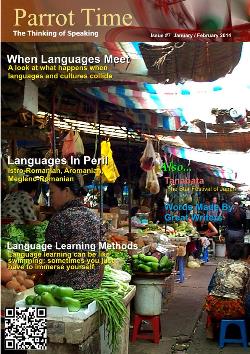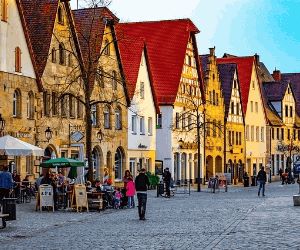Tanabata - The Star Festival

|
Japan has many festivals throughout the year, but one of the most visually striking is the Tanabata festival, held each year in July. It celebrates the story of two lovers among the stars, a princess and a cow herder, and how they get to meet for this one time each year. Chinese Origin 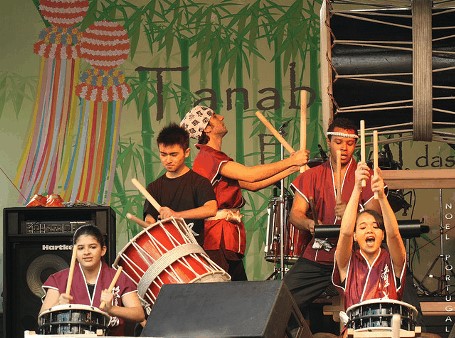 Musicians performing during the festival Originally, the Tanabata festival was a celebration of a Chinese folktale, “The Princess and the Cowherd”, which told of two lovers. Orihime spent all her time weaving beautiful cloth on the banks of the Amanogawa river for her father Tentei , who loved it. While it made him happy, she was sad, because she never had the time to meet anyone and fall in love. Tentei wanted her to happy too, so he arranged a meeting between her and Hikoboshi, a cow herder who worked on the other side of the Amanogawa. They fell in love the moment they met and soon were married, but it didn't work out well. As lovers will, they spent all their time together and neglected their tasks. Orihime no longer wove any cloth for her father, and Hikoboshi left his cows unattended, so that they were soon wandering freely all over. In anger, Tentei forbid the two from being together, and separated them again across the river. When Orihime became extremely upset and cried over being apart from her husband, his anger faded a bit, and he gave the couple permission to meet once a year, on the seventh day of the seventh month, as long as Orihime continued working hard on her weaving. The legend says that the first time they tried to meet, they found there was no bridge across the river, and Orihime began crying again. This time, her weeping fell upon the ears of all the world's magpies, who came to the lovers and formed a bridge with their wings, so the weaver and the cow herder could meet. It is believed that if it rains on the day of the festival, the magpies can't come, and so the couple must wait another year before meeting. 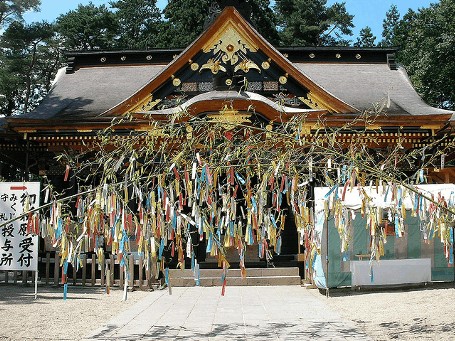 Many tanzaku hanging from a large branch A slight variant on this is that on the evening of the meeting, a boatman will arrive to take Orihime across the river. If the princess has not given her best weaving, however, Tentei might make it rain so the river floods and the boatman cannot come. In that case, the magpies will come and make the bridge. All of the characters are represented as objects in the sky. Orihime is the star Vega; Hikoboshi, also known as called Kengyū, is the start Altair; the river Amanogawa is the Milky Way constellation; Tentei is the universe; and the boatman is the moon. For this reason, the celebration was called "Star Festival". It was celebrated on the seventh day of the seventh month of the lunisolar calendar, so it was written written as "seven evening", 七夕, or Qīxì. This celebration was also known as "The Festival to Plead for Skills", 乞巧奠, Kikkōden, in which young people would pray for abilities that would aid them, such as girls wishing for better sewing, weaving and crafting skills and boys wishing for better handwriting. These prayers would be written on strips of paper and tied to trees. Japanese Adoption Ateji Another example is the word "Paris", referring to the capital of France. In katakana, it is usually written as パリ, which breaks down to "pa" and "re", which is a close pronunciation. It can also be written as 巴里 using ateji, but those characters don't translate into anything regarding the city. Empress Kōken of Japan adopted this festival in 755, during the feudal period, making it an official event at the Imperial court. It became popular among the people and was mixed with other traditions, like Obon (a Japanese Buddhist tradition to honor the spirits of one's deceased, similar to Mexico's Day of the Dead). Obon was at that time celebrated on the 15th of the seventh month, so people tended to celebrate them together. Around this time, there was a Shinto purification ceremony in which a Shinto miko, or priestess, would weave a special cloth made on a loom. This special loom was smaller than normal, and could be kept on a shelf, so it was called a "shelf loom", 棚機, or "Tanabata". This name then became attached to the new festival, which celebrated a princess weaver, and the Tanabata festival was born. The Japanese then took the Chinese characters of 七夕 and began pronouncing them as "Tanabata" through a process known as ateji. Date The date for Tanabata can be a bit confusing. Originally it was set for the seventh day of the seventh month, but that was based on the lunisolar calendar, which sets its months according to the cycles of the moon. The modern Gregorian calendar is a solar calendar, which was created to match with the seasonal changes. The first lunar month starts in what is the second Gregorian month, February, so the original date for Tanabata was actually in August. For this reason, Tanabata is celebrated in July in some places, and in August in others. Obon was similarly celebrated on the 15th of the seventh month, but it was moved back to it's lunisolar position of being in August. Celebration 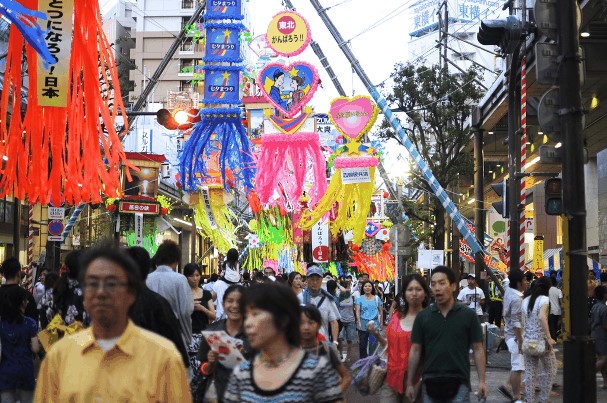 Street showing a variety of festival decorations The festival is celebrated in slightly different ways according to region. The tradition of praying for skills has been expanded to be prayers and wishes for anything. During Tanabata, branches of bamboo are erected all over, some of them small while others are as big as trees, and the prayers, written on coloured strips of paper called tanzaku (短冊), are tied to these. Other paper ornaments may be hung as well. These will eventually be burned, thus sending the wishes directly up to the gods, or cast into rivers and streams, to float away with the current. This water sending is a variant of the Obon tradition of setting illuminated paper lanterns afloat. Another common site are the Tanabata ornamental balls, called Kusudama (くす玉). They are a relatively recent addition to the festival, being first created in 1946 by a shop owner in Sendai. The balls are normally made by tying dozens of tissue paper flowers to a round bamboo frame, although more recently, box-shaped ornaments have also become popular. The balls are hung with streamers coming down from them, which are supposed to symbolize the weaving of threads. You can see these in many places several days before the actual festival. There is often a competition for the best decorations as well. Vocabulary
Throughout the festivities there are parades, vendors selling food and treats, and a general carnival atmosphere. Some places even have a "Miss Tanabata" beauty contest. At night, firework shows are common in many places. The most famous Tanabata festival happens in Sendai from August 6-8. São Paulo, Brazil, also has a Tanabata festival in the first weekend of July. PT |
| Celebrations - Tanabata | ||||||||||||
| Writer: | Sonja Krüger | |||||||||||
| Images: | ||||||||||||
| ||||||||||||
| Sources: | ||||||||||||
| ||||||||||||
All images are Copyright - CC BY-SA (Creative Commons Share Alike) by their respective owners, except for Petey, which is Public Domain (PD) or unless otherwise noted.
comments powered by Disqus









